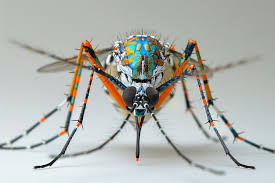Fleas are more than just a nuisance; they can cause discomfort for both you and your pets, and if left unchecked, they can lead to infestations that are tough to manage. To reclaim your home from these tiny invaders, it’s crucial to understand their lifecycle, effective preventive measures, and the best treatment options. This comprehensive guide will walk you through everything you need to know to keep your home flea-free.
Understanding Fleas: A Quick Overview
Fleas are small, wingless insects that feed on the blood of animals and humans. Despite their tiny size, they can jump up to 13 inches, allowing them to easily move between hosts and spread quickly.
The Flea Lifecycle
To effectively control fleas, it’s important to understand their lifecycle, which includes four stages:
-
Eggs: Adult fleas lay eggs on their host, but the eggs often fall off and scatter in the environment.
-
Larvae: These worm-like creatures feed on organic matter, such as flea dirt, found in carpets and bedding.
-
Pupae: The larvae spin cocoons and develop into pupae. This stage is highly resistant to environmental conditions.
-
Adults: Once conditions are favorable, adult fleas emerge, ready to find a host and start the cycle anew.
Understanding this cycle is key to effective flea management, as treatments often need to target multiple stages.
Signs of a Flea Infestation
Before you can tackle the problem, it’s essential to identify whether you have a flea infestation. Here are common signs:
-
Frequent Scratching: Pets scratching excessively is a common indicator of flea bites.
-
Flea Dirt: Small black specks found in your pet’s fur or bedding may be flea feces.
-
Flea Sightings: Spotting fleas on your pet or in your home confirms their presence.
-
Bites on Humans: Flea bites often appear as small, itchy red bumps, usually around the ankles or legs.
Preventing Fleas in Your Home
Prevention is always better than cure. By taking proactive steps, you can minimize the chances of a flea infestation.
Regular Pet Grooming
-
Bathing: Wash your pets regularly using flea-repellent shampoos.
-
Brushing: Use a flea comb to catch and remove fleas from your pet’s coat.
-
Topical Treatments: Apply vet-recommended flea prevention treatments, such as spot-on solutions or flea collars.
Maintaining a Clean Environment
-
Vacuum Frequently: Focus on areas where your pets spend time, including carpets, rugs, and furniture.
-
Wash Bedding: Launder pet bedding and other washable items in hot water to kill fleas and eggs.
-
Yard Maintenance: Trim grass and bushes to reduce flea-friendly environments.
Limit Outdoor Exposure
While outdoor playtime is essential for pets, limiting their access to flea-prone areas can reduce the risk of infestations.
Treating a Flea Infestation
If you’ve confirmed an infestation, prompt action is crucial to eradicate fleas effectively.
Treat Your Pets
-
Consult a Veterinarian: Your vet can recommend appropriate flea treatments for your pets, including oral medications, topical applications, or injections.
-
Use Flea Shampoos: Bathe your pets with a medicated flea shampoo to kill fleas on contact.
Treat Your Home
-
Insecticides: Use sprays or foggers designed to kill fleas at all life stages. Follow the product instructions carefully.
-
Diatomaceous Earth: This natural powder can be sprinkled on carpets and upholstery to dehydrate and kill fleas.
-
Steam Cleaning: High temperatures from steam cleaners can kill fleas and their eggs.
Treat Your Yard
-
Outdoor Insecticides: Apply flea-control sprays in your yard, particularly in shaded and damp areas.
-
Beneficial Nematodes: These microscopic organisms feed on flea larvae and can be introduced into your lawn as a natural control method.
Natural Remedies for Fleas
For those seeking eco-friendly alternatives, natural remedies can offer relief.
-
Vinegar Spray: Mix equal parts water and vinegar in a spray bottle and apply it to pet bedding and carpets.
-
Lemon Water: Boil sliced lemons in water, let it cool, and use it as a spray for furniture and pet areas.
-
Essential Oils: Certain oils, like lavender and cedarwood, act as natural flea repellents. Use them sparingly and consult a vet to ensure they are safe for your pets.
Long-Term Flea Control Strategies
Once you’ve eliminated fleas, it’s essential to implement strategies to prevent future infestations.
Routine Inspections
Regularly check your pets for fleas, especially after outdoor activities. Pay close attention to common flea hotspots like the neck, belly, and base of the tail.
Consistent Cleaning
Maintain a cleaning schedule for your home, including vacuuming, washing bedding, and wiping down surfaces.
Year-Round Prevention
Flea activity may peak during warmer months, but year-round prevention is crucial. Continue using preventive treatments on your pets and maintaining a clean environment.
When to Call in the Professionals
If your efforts aren’t yielding results, professional pest control services can help. Trained experts have access to advanced treatments and equipment to address severe infestations effectively. Hiring professionals may save time and effort while ensuring thorough eradication.
Final Thoughts
Dealing with fleas can be challenging, but with the right knowledge and consistent efforts, you can protect your home and pets. Whether you choose natural remedies, commercial treatments, or professional services, addressing the issue promptly is key to success. By following the strategies outlined above, you’ll not only eliminate fleas but also create a healthier environment for your family and pets.
Remember, effective pest flea control requires a combination of preventive measures, treatment, and maintenance. Stay vigilant, and you can enjoy a flea-free home all year round.
